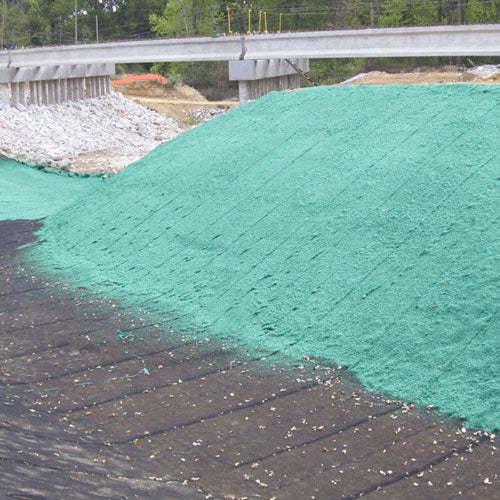Hydroseeding Solutions: A Greener Approach to Land Management
Best Practices for Erosion Control in Construction Projects
Are you working with a building job and worried regarding disintegration control? Look no more! In this post, we will assist you with the very best practices for avoiding erosion on your site. You'll uncover five important methods, effective sediment and overflow administration methods, vital factors to consider for incline stablizing, and tips for protecting vegetation and soil. We'll also explore the significance of executing appropriate water drainage systems. Prepare to deal with erosion head-on and make sure the success of your construction project.
5 Necessary Erosion Control Strategies
To properly regulate disintegration on your building and construction website, you'll require to apply important methods such as slope stabilization and sediment control actions. Incline stablizing is critical in stopping dirt disintegration on steep slopes. Another efficient method is the use of erosion control blankets or mats, which are put on the slope and assistance preserve dirt bits while enabling plants to grow.
Efficient Sediment and Runoff Management

You can effectively take care of debris and runoff in your building job by implementing proper disintegration control actions. Debris and overflow management is important to stop disintegration and secure the surrounding setting. One reliable measure is the installation of silt fences along the perimeter of the building site. These fencings aid to have debris and stop it from entering nearby water bodies. Another essential method is the application of erosion control blankets or mats. These blankets provide a protective layer on bare dirt, reducing the impact of rainfall and preventing disintegration. In addition, the usage of sediment containers or debris catches can assist to capture sediment and prevent it from entering stormwater systems. Normal upkeep of these procedures is essential to ensure their effectiveness throughout the construction project. This consists of inspecting and cleansing sediment basins and frequently replacing silt fencings and disintegration control blankets as required. By executing these disintegration control procedures, you can successfully manage debris and runoff in your building and construction job, reducing the impact on the setting and complying with regulatory demands.
Trick Considerations for Incline Stablizing
When thinking about incline stablizing, it is very important to analyze the terrain and determine possible areas of instability. You need to meticulously analyze the incline's characteristics, such as its structure, angle, and water drainage patterns. Seek indications of erosion, such as subjected origins, splits, or slumping dirt. These indications can give you an idea of where stabilization steps might be necessary.
Another alternative is to grow vegetation on the slope, as the origins can help secure the soil and control disintegration. In addition, mounting erosion control blankets or mats can supply instant protection while vegetation becomes well-known.
It's crucial to frequently monitor the maintained slopes to guarantee their performance. Keep an eye out for any indicators of movement or disintegration, and take immediate activity if required. Regular maintenance, such as inspecting and repairing any kind of damaged measures, is likewise important to make sure long-lasting stability.
Finest Practices for Plant Life and Soil Defense
One effective means to protect vegetation and dirt on slopes is by regularly inspecting for indications of disintegration and taking immediate activity if required. Beginning by examining the slope for any kind of indications of disintegration, such as subjected origins, bare soil patches, or debris build-up at the base. Implement erosion control actions such as installing erosion control coverings, mulching, or even article source creating keeping wall surfaces if needed.
Applying Appropriate Drain Equipments
To efficiently implement correct drainage systems, it's vital to consider the slope gradient and soil kind. When it comes to handling water circulation and avoiding disintegration, recognizing these elements is vital. The slope gradient plays a substantial role in identifying how water relocates throughout the land. Steeper inclines can lead to faster water circulation, increasing the risk of erosion and flooding. On the other hand, gentler slopes enable water to flow much more gradually, minimizing disintegration possibility. By analyzing the slope gradient, you can make an effective drain system that fits the all-natural water movement.
Sandy soils often tend to drain pipes faster due to their crude texture, while clay soils have a slower drain price due to their compact nature. In addition, thinking about the dirt attributes assists protect against waterlogging, which can lead to bad plant growth and damage to frameworks.
Final Thought
In verdict, when it comes to disintegration control in building and construction projects, you need to comply with these ideal practices. Apply effective sediment and overflow monitoring strategies to protect against air pollution. Consider slope stabilization methods to make sure the stability of the website. Shield vegetation and soil by utilizing proper actions. Finally, establish appropriate water drainage systems to manage water top landscape architecture firms flow. By complying with these necessary practices, you can effectively control erosion and guarantee the success of your building task.
To efficiently control disintegration on your building and construction website, you'll need to execute important techniques such as slope stabilization and sediment control actions. Incline stabilization is essential in protecting against wikipedia reference soil erosion on high inclines. One more effective method is the use of erosion control coverings or floor coverings, which are placed on the incline and aid preserve soil fragments while allowing greenery to grow. An additional alternative is to plant plants on the slope, as the origins can assist anchor the dirt and control erosion. Implement disintegration control steps such as setting up disintegration control blankets, mulching, or also building retaining wall surfaces if needed.